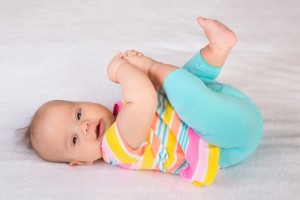
What a beautiful sight to see a little baby, quietly sleeping in his or her crib! Are they at risk by sleeping under a hand-made blanket by a grandmother, or surrounded by bumper pads that match the nursery decor? What about a stuffed bear sitting in the corner of the crib?
It is important to make sure that the environment your baby sleeps in is a safe one. October is National Sudden Infant Death Syndrome (SIDS) Awareness month. In 2011, the number of deaths in North Carolina attributed to Sudden Infant Death Syndrome (SIDS) was the lowest in our history. While SIDS is not preventable, there are specific recommendations that can reduce the risks of SIDS.
In 2011 the American Academy of Pediatrics (AAP) expanded their recommendations for a ‘Safe Infant Sleeping Environment.’ (PEDIATRICS Volume 128, Number 5, November 2011). There has been a major decrease in the incidence of SIDS since 1992 when the AAP released their recommendation that infants not be placed on their tummy to sleep. However, the decline has reached a plateau in recent years as other causes of sudden unexpected infant death have increased.
To help make sure your infant is in a safe sleep environment, follow these expanded recommendations from the American Academy of Pediatrics:
-

Happy, well rested baby Place your baby on his or her back to sleep for naptime and bedtime
- If your baby falls asleep in a car seat, swing, or carrier, move them to their crib as soon as possible
- Infants should sleep alone in their own bed. Sleeping in the same room with a parent can be convenient and reassuring but they need their own space
- Use a crib or bassinet that meets all current safety standards (cribs manufactured after 6/2011)
-

No toys in crib and no loose sheets The mattress should be a well-fitting, firm, flat one covered with a tight-fitting sheet
- Leave soft objects, toys, bumper pads and loose bedding, and pillows out of the crib
- When using portable cribs, play yards, bassinets, etc., make sure they have a sturdy bottom, wide base, smooth surfaces, and legs that lock to prevent folding while in use
- Keep your home a smoke-free environment. Even second-hand smoke increases the risk
-

Baby in layers won’t get too cold or hot (remove layers as needed) Breastfeed your baby
- Use a pacifier at nap and bedtime. If you are nursing, wait until breastfeeding is well established (usually 3-4 weeks) before giving a pacifier
- Make sure all childhood immunizations are up to date
- Avoid using devices such as wedges, pillows, or supports that keep babies on their back
- Dress your baby in layers and avoid over-heating. Consider using a sleep sack with only a t-shirt underneath for sleeping instead of a blanket
- Provide supervised ‘tummy time’ at least one or more times a day for your baby when he or she is awake. When sleeping on their back, you can turn their head to one side or the other to help prevent the back of the baby’s head from getting flat
Talk with your pediatrician about any concerns you may have about your baby’s health and safety. For more information about SIDS, check out the following websites:


